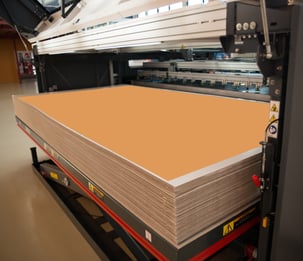Wide-format printing, a large and resilient category, continues to show potential for growth and profitability. If you haven’t delved into wide format, it can be a significant new revenue stream for your print operations.
Definitions vary, but for our purposes, wide format means inkjet devices with printing widths of roughly five feet and greater. Encompassing many applications—posters, banners, pop-ups, labels, back-lit displays, textiles, home décor, wall art, and packaging—it also excels at very short runs with variable printing and customization.
If you are planning to expand into wide format, consider the following:
- Start with your customers
To assess which wide-format services are practical, start by talking to your customers about their purchases. What are they buying and where are they buying it? If they were to switch their orders to you, is this base enough to grow into a substantial business?

- Know what you want to print
Before choosing a printing press, decide what you want to print. The work on which you choose to focus will determine the substrates and ink, resolution and thickness requirements, costs, and the environment where the work will be displayed. The substrates available for wide format are almost limitless and include canvas, metal, vinyl, glass, plastics, wood, and yes, paper, but no single device will print on every substrate.
- Research the equipment
Wide-format equipment choices are abundant. Printers come as roll-to-roll for soft substrates such as vinyl, or flatbed for rigid materials such as metal and gatorfoam board. Hybrid models can switch between the two for greater flexibility.
Textiles, for example, require printers capable of dye sublimation, where inks are diffused into textiles. Outdoor signs need printers that can handle solvent inks, which are more durable and resistant to fading. Consider the resolution you’ll need. A large banner in a huge conference hall doesn’t need the same fine resolution as counter-top displays or wall art. Do you need white ink capability?
Be prepared to devote considerable time to researching all the equipment options and configurations. Understand what each printer can do, its potential, and, crucially, its running costs.
- Does it integrate with MIS and other systems?
Ideally, you’ll want to integrate your wide-format devices into your MIS systems, web-to-print platforms, other workflows, and RIP devices. What software upgrades will you need and who will handle the required integration?
- Finishing adds a wow factor
A cutting table is key for a flatbed printer and rigid substrates. A laser device with intricate cutting capabilities, for example, can give any job a wow factor that adds value and profits. Manufacturers can optimize various devices to work well together.
- Pick the right vendor
Research vendors carefully. A good vendor will assess your operation and recommend the best devices without unnecessary up-selling. When you need them, accessing a technician quickly is a must. Also consider warranties, the training provided—especially with software integration—equipment upgrades, retrofits, and replacement heads. Discuss leasing options with them if that works for you.
- The business model is a little different
Wide format is unlike offset. The myriad inks and substrates impact supply chains and inventory management. Costing differs from offset, where unit prices decrease as runs increase. Sometimes, you must price by square footage, for example. Prices for supplies can also fluctuate more wildly.
- Branch out to consumers
![for sale [Converted]](https://www.rogergimbel.com/hs-fs/hubfs/Blog/for%20sale%20%5BConverted%5D.png?width=164&name=for%20sale%20%5BConverted%5D.png)
Wide-format can be perfect for extending your reach to the consumer market in part because it makes brief runs and variable work feasible. Many printers are fulfilling orders on sites like Etsy or creating their own websites where consumers can upload images for printing on metal, glass, canvas, or fabric. Think wall stickers, art works, t-shirts, or customized metal signs. It’s endless.
- Dip your toe with a partnership
To explore the wide-format world without taking the plunge, partner with a reseller and get a feel for potential demand and sales strategies.
- Develop a niche expertise
Consider developing an expertise in a certain niche, while remaining flexible enough to do other work. Niche work is consistent and keeps the presses running.
Need help with adding wide format to your business? Contact G&A for a free consultation on how we can assess your needs and implement your goals. 

